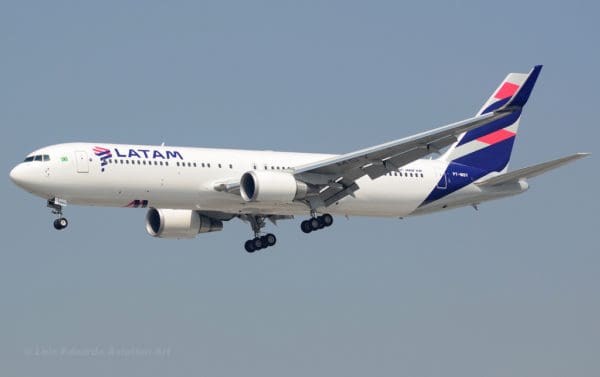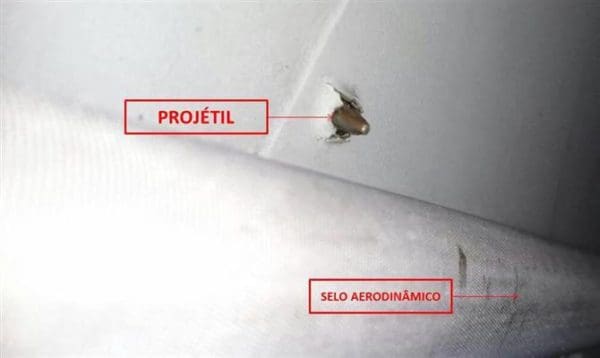There’s a series of steps that need to happen before a passenger airliner pushes back from the gate to go fly off into the distance. One of the more important parts of that process is the pre-flight inspection of the aircraft. The pilot (or, more often, the lowly first officer — especially if its raining) walks around the exterior of the aircraft and inspects it for any damage or if anything looks out of the ordinary. The hope is that the process would catch any issues before the aircraft even left the gate, much less left the ground. It looks like a couple LATAM pilots may have missed something on their pre-flight: a bullet hole in the wing of their aircraft.
According to sources the bullet hole was discovered in the wing of the aircraft during a routine inspection at the LATAM maintenance facility in Brazil. Routine maintenance is carried out on commercial aircraft either every 100 flight hours or according to a government approved maintenance schedule.
The wings of an aircraft are more than just mechanics, they also contain the main fuel tanks for the flight as well as hydraulic lines which allow pilots to manipulate the control surfaces on the wing and direct the aircraft to turn. Even a small hole in one of these systems would be catastrophic. In 2007 a China Airlines 737 caught fire and burned to the ground after a loose bolt made a small hole in the fuel tank. A 1989 United Airlines crash killed 112 people when the hydraulic systems were bled dry and the pilots could no longer properly control the aircraft.
LATAM says that they aren’t sure where the plane was located when the damage occurred, as the aircraft has been flying numerous routes around the world to locations including New York. A similar incident happened to a US Airways Boeing 737 in 2011, but that hole was detected during the pre-flight inspection and the aircraft did not carry any passengers in that condition.






Must have been one of those .50 sniper rifles that California and New Jersey wants to ban.
I heard they can blow up railroads.
😉
They can blow up moons.
Yeah, I know, I suck the joy out of everything 😉
Good thing it was only a .50 BMG and not the dreaded .88 magnum.
https://www.youtube.com/watch?v=Hd-0F4v1C54
“LATAM says that they aren’t sure where the plane was located when the damage occurred, as the aircraft has been flying numerous routes around the world to locations including New York…”
Plane is currently in Brazil. Brazil is probably the most likely place in the Americas (tied with Mexico and Chicago) for the bullet-to-air ratio to be high enough for a plane to take fire.
Hoofprints are likely from a horse, not a zebra.
Celebrarory fire into the air. where was it on the 31st?
Ground fire was light to moderate that day.
Delta still complained.
Black and White hides matter.
So the bullet didn’t make it all the way through the airplane’s thin aluminum skin. Wild guess: The plane was at such an altitude that the bullet didn’t have much velocity when it hit.
Lucky shot, to be sure, but you wonder how many rounds were fired at it.
And it didn’t deform the bullet tip at all?
My spidey senses are tingling.
It likely wouldn’t. Aircraft skin is generally thin aluminum throughout. The 787 and some Airbus models are overwhelmingly carbon fiber/composite material. Fuel tanks are a relatively soft self-sealing material. There’s very little on commercial aircraft bodies that would deform a jacketed round.
Hit the landing gear, fan blades, or engine body and it would certainly deform/disentigrate.
The plane may have been on the ground and the bullet may have been fired from a long distance and came down from above.
Although the picture doesn’t give any orientation clues, it seems that the bullet struck from above. Which makes your scenario extremely likely.
Do we even know the picture is actually a picture of the plane in question and not a file photo from somewhere?
Poor penetration. Must have been a subsonic 300 blackout.
And in defense of the first officer, the 767 wing is far off the ground so it’s not likely he can see a speck on the wing that turns out to be a lodged bullet.
At the last Red Flag event we had a small dent on the leading edge of our wing. We found it during the post flight walk around. Mx got on a ladder and took a closer look: there were larger dents and holes punched in the wing and on top of the body.
During the air-air shot eval we closely watched for chaff/flare events and found a eurofighter had punched off flares right above/in front of us. Damn golden BB got us right in the wing. The flare would have burned out before drifting into our flight path, so it would have been a small chunk of near-invisible matter. At 650kts or so (on egress) no one saw it.
Anyway, cool story bro.
Care to interpret for the rest of us?
It’s in English. Mx – maintenance.
I think he means translate from cockpit monkey speak to normal monkey speak.
Anner flies things with pointy noses that go fast and shoot stuff (assumption based on context). He trains with others who do the same. At a training event, another dude ejected stuff from his plane that makes it harder to track/target him for a short time. Anner was too close when the other guy did this and flew through debris of said stuff. This damaged Anner’s aircraft. They had to look at the playback of the training event to realize that that is what happened because things happen so fast.
Hope this was sufficient.
golden BB….
“Golden BBs” tend to create unlikely and disproportionately high damage against whatever they were fired at. This round did neither and therefore does not qualify as a golden BB. Reference google “Golden BB” for details and citation.
New Year’s celebration shot?
South American road rage? Drive-by?
Somebody finally found out how to roll down the window while everyone was sleeping and it was self inflicted.
In my opinion, the bullet should have reach the airplane in Rio de Janeiro. There are many drug dealers and criminals with FALs and .30 machine guns, as others. Due to the low penetration, i guess the projectile traveled a considerable distance (from a slum to Galeao Airport, for example) and lodged in the wing.
Actually knowing something about aircraft and aircraft structure, I am pretty sure this didn’t actually penetrate the wing box (i.e. the main wing structure where all the fuel is). The aluminum on the wing box of commercial aircraft are typically pretty thick and it wouldn’t go through both sides of the wing. This pictures is not from inside the wing where the fuel is because there is no fuel tank sealant. It looks like it went through some exterior fairing or flight control surface on the wing.
If it helps, “selo aerodinamico” is Portugese, means “aerodynamic seal”.
Yep, it looks like that fairing is one of the flap control fairings and the hole is almost certainly in the flap or flap well of the wing. Looks to me like fiberglass or carbon fiber where the bullet penetrated.
Reminds me of a news story when I was living in Durham NC in the late ’80s. There were a couple of guys with rifles, in the woods south of the RDU airport. One of them thought it would be fun to take a shot at a passenger plane as it flew over them on its landing approach. As I recall it penetrated the fuselage and stuck a passenger in the thigh.
Honest to God officer, it looked like a duck!
Pffffttttttttt … that there was funny!
According to LATAM the round impacted one of the leading edge flaps.
The crew and normal maintenance checks between flights would never have found this. This has to be one of the luckiest \ unluckiest shots I have ever heard about with proof. 1 ft forward it would have missed the aircraft. 1 ft aft it would have hit the wing skin
Either way pretty interesting story
This is an extremely dangerous event. We at MAP call for laws banning all airplanes. Pilots might miss observing airborne debris and damage it with their planes. Remember the poor geese in NY in the late ’60s? That the plane tail landed in an intersection in busy Manhattan bears witness to how often geese are endangered.
MAP is Mothers Against Planes. All planes must pass a Universal background check. An 8 day waiting period before takeoff will be required under new common sense laws.
Is that a spin off group from MILF?
Moms Incensed at Low Flying
Definitely looks like it came through the top of the structure. Missed the fuel tanks, hydraulics, and actuators.
Damned lucky. I’m an aircraft mechanic. Wings are full of equipment as well as fuel. An inch in any direction could have been disastrous.
I’m guessing one of the baggage handlers / narcos suffered a ND while inspecting the latest contraband delivery courtesy of the ATF.
“The pilot (or, more often, the lowly first officer — especially if its raining) walks around the exterior of the aircraft and inspects it for any damage or if anything looks out of the ordinary.”
Many years ago, I was briefed by my Captain that he’d do the walkarounds when it was raining hard. During a torrential downpour at Chicago O’Hare, it was time for me to head outside for the preflight. I looked at the Captain, expecting him to doff his hat and coat and pick up my slack. Instead, he looked all directions out the cockpit glass, looked back at me, and said, “nope, not raining hard enough!”.
I’m sure it was an old joke, handed down over decades. Can’t wait to use it on a new hire.
I enjoyed that one! Thanks for the laugh…
Comments are closed.